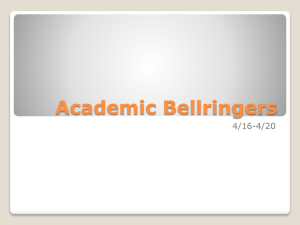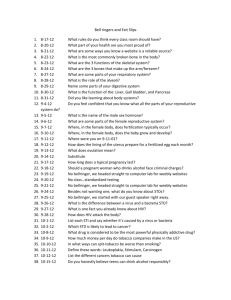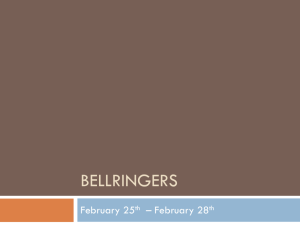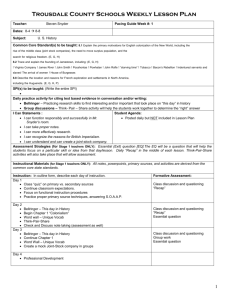Physical Science Bellringer Activities - High School
advertisement
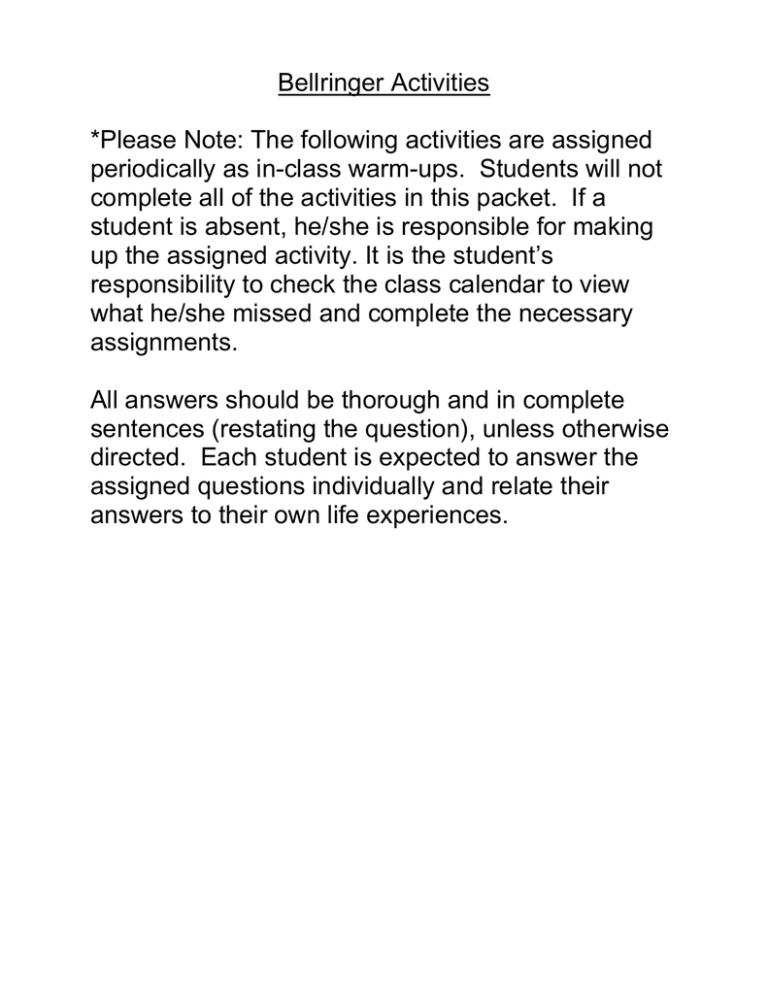
Bellringer Activities *Please Note: The following activities are assigned periodically as in-class warm-ups. Students will not complete all of the activities in this packet. If a student is absent, he/she is responsible for making up the assigned activity. It is the student’s responsibility to check the class calendar to view what he/she missed and complete the necessary assignments. All answers should be thorough and in complete sentences (restating the question), unless otherwise directed. Each student is expected to answer the assigned questions individually and relate their answers to their own life experiences. INTRODUCTION TO PHYSICAL SCIENCE Bellringer 1.1 Explain how firefighters need to have some knowledge of physical science to perform their jobs. Bellringer 1.2A What is a problem that your recently solved (such as having to fix something or having to decide how to proceed in treating an injury) and what were the steps you used in solving this problem? Bellringer 1.2B If you had to describe an orange to someone who had never seen an orange, what would you tell the person? Bellringer 1.2C How can you prove the world is not flat? Bellringer 1.2D Explain what a controlled experiment is and why it is always important to control variables in such an experiment Bellringer 1.3A What are some of the units of measure you use in every day life? Why do you think there is a difference in the units of measure people use around the world. Bellringer 1.3B How does a standard system of weights and measures – one that is agreed to and used around the world – make life easier? Bellringer 1.3C Explain what density is and how you can determine if a substance will float in water. Bellringer 1.4 Explain how in the game of darts, the results can be 1) neither reproducible nor accurate 2) reproducible but not accurate and… 3) both reproducible and accurate. You may include diagrams with your written answer. Bellringer 1.5A Why are graphs useful and what are three basic types of graphs that scientists use? Bellringer 1.5B When creating a line graph, scientists sometimes draw a line of best fit…why? THE NATURE OF MATTER Bellringer 2.1A What are some things that can be classified as matter? What two properties does all matter have? Challenge: Can you think of anything that is not matter? Bellringer 2.1B Explain why melting, freezing and boiling are physical properties of matter. Bellringer 2.1C Explain how chemical properties differ from physical properties. Bellringer 2.1D How are compounds different from the elements that make them up? Why is the ratio of elements in a compound important? Bellringer 2.2A How does a chemical change differ from a physical change? Bellringer 2.2B How does the law of conservation of mass apply to combustion? Bellringer 2.3A What energy transformations occur when you ride a bike? STATES OF MATTER Bellringer 3.1 How do the motions of the particles in ice, water and steam differ? Explain and draw a picture to represent your ideas. Bellringer 3.2 What are some examples of vaporization? What are some examples of condensation? Bellringer 3.3A How does a hot-air balloon rise? Bellringer 3.3B Why should people check the air pressure in their tires in the winter? ELEMENTS AND THE PERIODIC TABLE Bellringer 4.1A An atom is the smallest particle into which an element can be divided and still be that element. Now that scientists have learned that an atom is made up of even smaller particles, is this definition still accurate? Bellringer 4.1B What are the three particles of an atom and where are they found within an atom? Bellringer 4.2 Explain how Mendeleev used cards to make his first periodic table. Bellringer 4.3 Think of all the ways a deck of cards could be laid out so that the cards form some sort of identifiable pattern. Describe as many different patterns as you can. ATOMS AND BONDING Bellringer 5.1 Suppose you decide to build a wooden birdhouse. You are not sure how to fasten the pieces together. What are three ways you could fasten the wood together? Can you think of any other ways? Explain which way you think would work best. Bellringer 5.3 Explain why covalent bonds usually form between atoms of nonmetals, whereas ionic bonds usually form between atoms of metals and nonmetals. CHEMICAL REACTIONS Bellringer 6.1A Name some changes of matter and state whether they are chemical or physical. Bellringer 6.1B What are the five clues that a chemical reaction has taken place? Bellringer 6.2 Chemical reactions have reactants and products. Do you think that the products of a reaction are always more complex than the reactants? Could the products be simpler than the reactants? Explain your answer. Bellringer 6.3 Now that you know a little about chemical reactions, think about the many chemical reactions that take place around you every day. Describe your favorite chemical reaction. How do you think energy is involved in the reaction? ACIDS, BASES AND SOLUTIONS Bellringer 7.1 Consider a lemon and tomato. These fruits contain citric acid, which gives them a tangy flavor. Suggest other foods whose tanginess may be due to the presence of acids. Bellringer 7.1B Imagine mixing a spoon of sugar in a glass of water. Would you be able to see a difference between the sugar water solution and plain water? How could you tell the difference between the two? How do you know that the sugar water is a mixture and not a compound? Bellringer 7.2 How can you increase the concentration of a solution without changing the amount of solvent? How can two solutions have the same concentration if one solution has twice as much solvent? Bellringer 7.3 Create a chart and list the properties of acids and bases. CARBON CHEMISTRY Bellringer 8.1 Graphite is a form of carbon that is present in pencil lead. Explain why the structure of graphite carbon is useful in when writing with a pencil. Bellringer 8.2 What is the difference between an organic compound and an organic fruit or vegetable? Bellringer 8.3A How is a polymer built? Draw a representation of a polymer and label the parts. Bellringer 8.3B Synthetic polymers are made from coal or oil. The most common synthetic polymer is plastic. Why do you believe that synthetic polymers have been produced and what is their benefit? What are some problems with synthetic polymers and how can we help solve these problems? MOTION Bellringer 9.1A Describe three examples of motion you observed on the way to school today. Make note of the reference point in each example. Bellringer 9.1B Describe your position in the classroom using a reference point and a set of reference directions. For example, you might say, “ I sit three desks behind Ahmed’s desk,” or “I sit 2m east of the vent hood and 10m north of the emergency shower.” Bellringer 9.2 Think about a recent trip that you have taken. What was the approximate total distance that you traveled and the total time it took? Calculate your average speed from this information and explain how your instantaneous speed varied over the course of the trip. Bellringer 9.3A Explain two ways an object’s velocity can change. Bellringer 9.3B Speeding Up, Slowing Down and Changing Direction What do all of these examples have in common? FORCES Bellringer 10.1 Force is always exerted by one object on another object. Look around the room and think about the objects you see in terms of force. Where do you see a force happening in the room right now? Which object is exerting the force and which object is receiving it? Bellringer 10.2A Suppose you and your younger brother or sister are swimming at a neighborhood pool. Your sister or brother asks why there are signs everywhere that say “NO RUNNING.” What would be your answer? Use your knowledge of the forces of friction to explain. Bellringer 10.2B Describe in your own words the difference between weight and mass. Bellringer 10.2C Describe the forces acting on a falling object. Bellringer 10.3A If you are sitting still in your seat on a bus that is traveling at 100km/h on a highway, is your body at rest or in motion? Explain your answer and use a diagram if it will help make your answer clear. Bellringer 10.3B Use Newton’s first law to explain what happens to passengers when a car stops quickly? Bellringer 10.4 In your own words, explain Newton’s three laws of motion. FORCES IN FLUIDS Bellringer 11.1 One afternoon, you go outside to find your younger sister standing by her bike with a nail in her hand. The bike has a flat tire. She wants to know why the air came out of the tire when she pulled the nail out. Write a few sentences to explain why air rushes out of a hole in a tire. Bellringer 11.2A Using what you know about density, floating and sinking, compare the densities of hot air and cool air. Bellringer 11.2B If a boat developes a leak and water rushes in, explain why the boat might sink. Bellringer 11.3 You are a mechanic who fixes hydraulic brakes. A customer asks you why his brakes do not work. When you examine the car, you notice a leak in the brake line and repair it. Write a note to the customer explaining why a leak in the brake line caused his brakes to fail. EARTH, MOON AND SUN Bellringer 12.1 Why is it usually colder near the poles than it is near the equator? Bellringer 12.2A Draw a diagram of the Earth and moon. What would happen if the mass of the Earth increased? Decreased? Predict what would happen if the Earth and moon were closer together? Farther apart? Bellringer 12.2B Why does a baseball continue to move after a pitcher lets go of it and stops applying force? Why will it eventually hit the ground? Bellringer 12.4 What evidence do you think might be used to support a theory that the moon was formed from material from Earth’s outer layers? SOLAR SYSTEM Bellringer 13.1 Could astronauts land on a star in the same way that they landed on the moon? Why or why not? Bellringer 13.2 Henry Thoreau once said, “The sun is but a morning star.” Explain what you think this quotation means. Bellringer 13.3 Suppose that you were in charge of gathering the materials and supplies needed to live on Mars for a month. What materials would you need? What would you eat? What would you breathe and how would you live?


